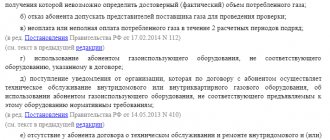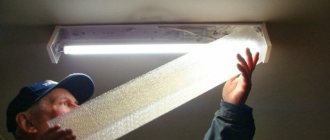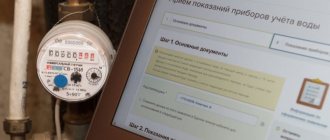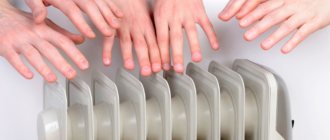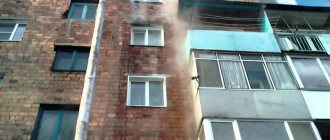Features of water supply to multi-apartment buildings
It is very difficult to establish water supply for a multi-storey building with numerous consumers. Each apartment in the house should be considered as a separate object for providing water: pipes of various diameters form a single structure with rather complex wiring. It is for this reason that water supply to a multi-storey building is considered very difficult.
The system is a whole complex of pumping equipment with installed filters and metering devices, as well as shut-off and control valves and apartment-by-apartment pipe distribution.
Pressure regulators will be mandatory in this scheme. The water that enters the apartments first goes through several stages of purification to remove mechanical impurities. Water is also often disinfected using chlorination.
Central water supply and water supply system
The most convenient way for people who live in apartment buildings is to supply water from a central water supply. This system involves supplying high-quality water under good pressure. Central water supply is carried out through a water supply system, which is available in all cities and villages. As a rule, water enters pumping stations from surface reservoirs that are located far from sources of pollution.
The central water supply system has three components:
- water intake structures;
- cleaning stations;
- distribution network.
Water flows from the pumping station into a specific reservoir. There it goes through numerous stages of purification and only then enters the distribution network to supply water to the necessary facilities.
The water supply system functions normally if the pipes are laid out in a high-quality and correct manner. System pressure also plays a big role.
For a large number of users, the central water supply system may have a well, which is arranged using a special water intake tower. It is best to use an artesian well: water is drawn from great depths, the quality of the water is high.
But this method of collecting water is considered quite expensive. It is usually used to provide water to an apartment cottage.
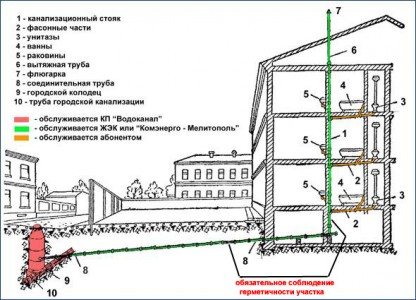
Diagram and design of the water supply system of an apartment building
Water supply system with water tower
Such a system has several main elements: a caisson, a main tank for water intake and a pumping station.
Working principle of a water tower
A caisson is a metal container located at a depth of 2-2.5 m above the well itself. A pipe is installed in it to drain water from the well. A concrete ring caisson is considered less airtight, since very often it is flooded by incoming groundwater.
Through the pumping station and the caisson, water enters the storage tank. It is equipped with an automatic float valve. It turns on the pump when the water in such a container drops and does not reach a certain level.
The total pressure in the system directly depends on the volume of the storage tank or tank. Even in the event of a power outage, water will flow into the apartments consistently. But until the water level in the tank drops and, accordingly, the pressure decreases.

Water tower design diagram
Types of pipes used for water supply
Steel pipes
Today, steel pipes have practically ceased to be used. Over a fairly long period of time, such materials for plumbing have used up their resources. In addition, the price of steel pipes is quite high.
Installation of steel pipes is also expensive and takes a lot of effort and time. The disadvantage of such a system is that condensate accumulates heavily on it, which can destroy the pipe material. Rust and plaque will gradually form inside the steel pipe, which reduces the volume of the pipe. Thus, throughput is also reduced.
Copper pipes
The most important advantage of using copper pipes is their service life, which reaches 50 years. Steel pipes are quite expensive, and not everyone can afford them. The advantage of steel pipes is that rust does not form on them. In addition, copper has bactericidal properties.

Copper pipe wiring
Metal-plastic pipes
Metal-plastic pipes are extremely popular today. They are quite practical and considered reliable. Installation of metal-plastic water supply is very simple. All you need is a special tool. The pipes are joined using fittings. The pipe can withstand significant mechanical and physical loads.
Metal-plastic pipes
Calculation of the total amount in 2020
Heating is the most expensive utility service. This is due to the fact that special heating devices are used for heating, which consume a lot of energy.
To calculate the amount of payment for heating up hot water, it is necessary to determine how much resource was spent; to do this, you need to take readings from the meter or make a calculation for hot moisture, if there is none. The amount of remuneration for heating hot water is calculated using the following formula:
P gv = Vgv × Txv + (V v cr × Vi gv / ∑ Vi gv × Tv cr)
Where:
V gv - the volume of hot water consumed during the billing period (month) in an apartment or non-residential premises
Tхв – tariff for cold water
V v cr – the volume of thermal energy used during the billing period for heating cold water during the independent production of hot water by the management company
∑ Vi gw – the total volume of hot water consumed during the billing period in all
T v cr – tariff for thermal energy in the premises of the house.
The rate established in the region is multiplied by the heat standard required to heat a cubic meter of liquid. The resulting figure is multiplied by the amount of resource consumed.
For residents who do not have a meter, the calculation must be made as follows: the standard is divided by the number of residents in the house (apartment). The resulting result will not be accurate, since the management company also adds costs spent on repairs, maintenance and ensuring the functionality of special devices.
Utility payments for heating hit homeowners' budgets hard. In connection with this, people do not want to contribute money for unknown reasons. And the appearance of a new column on paper for heating always raises questions, especially if you have to pay a considerable amount for the innovation. Heating recently appeared on the receipt, which is why many people still don’t understand why they have to pay for it separately, because they already pay for water supply.
Apartment water supply schemes
The stability of the operation of all household equipment that is connected to the water supply directly depends on how competently the installation of the water supply system is carried out.
The water supply scheme must provide the apartment with water from the central water supply to all necessary supply points. For some equipment it will be necessary to ensure constant water pressure in the pipes. At the moment, water supply for an apartment can be done in several ways: a series connection scheme, a collector and a mixed system.
Scheme of sequential water supply for an apartment
The simplest and most practical way to supply water to an apartment is considered to be a sequential connection scheme. This is an affordable option in terms of price and installation of utilities. This scheme is usually found in residential buildings.
According to this scheme, the installation of main pipelines supplying hot and cold water is carried out in parallel. Each equipment in such a system is connected using tees. It is for this reason that the serial connection circuit is often called a tee circuit.
Frequent examples of squeezing
Single handle faucet
A single-handle faucet has a cartridge installed, which is directly responsible for supplying water at a certain temperature by mixing hot and cold. By taking this cartridge apart and connecting each piece, you can see exactly how mixing occurs. Where does the water pressure come from and check how the device works. Some parts of the cartridge are not so tightly attached to each other, and this may cause squeezing. In this case, it is the replacement of such a cartridge that will eliminate the problem of squeezing.
Hygienic shower
The hygienic shower has three locking devices:
- The first two are a faucet that contains both hot and cold water.
- The third device is a button on the hygienic shower head. This button is designed to once and “forever” adjust the temperature of the supplied water on the mixer, and not return to this issue in the future. When you press the button, a small discharge of water occurs, after which the supply of water at a pre-set temperature begins.
In this case, in the absence of a check valve, the mixer is open and the hygienic shower button is closed. While the mixer is open, the supply of both hot and cold water is closed. Water cannot spill through a watering can or mixer of a hygienic shower.
Because the pressure in hot water is higher than in cold water, hot water displaces cold water further and further. After this, the same phenomenon occurs in which hot water flows from the cold water tap. And in this case, complaints may arise from other residents of the house.
Dismantling sewerage in an apartment
Replacing an old sewer pipe with a new one has many nuances that must be taken into account in this process. Initially, it is necessary to determine the places in the pipe that are most vulnerable to deformation. You also need to disconnect all existing connections from the pipe and remove all debris. All this is needed to ensure more convenient work.
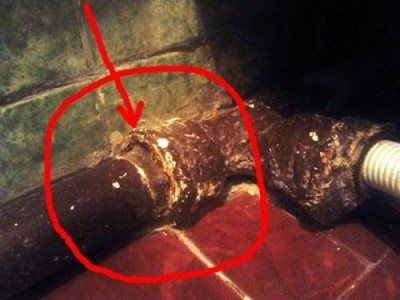
Then, near the riser, the tap is turned off, which supplies water to the apartment. If the replacement will take a long time, then it is best to completely disconnect the entire riser from the water supply. At the very last moment, it is necessary to carefully dismantle the cast iron sewer pipes. All this can be done using adjustable wrenches or other tools.
It is necessary to install a new pipe in a complete set with various adapters and couplings, since then it will not be possible to do it efficiently. All connections must be sealed with sealant to protect the riser from leaking.
Hot water supply
The hot water supply in an apartment is a whole system of pipelines and various devices that are used to heat cold water and distribute hot water to consumers. In some cases, special pipes are used in bathrooms or toilets to heat such rooms in the apartment. They have the additional function of dryers.
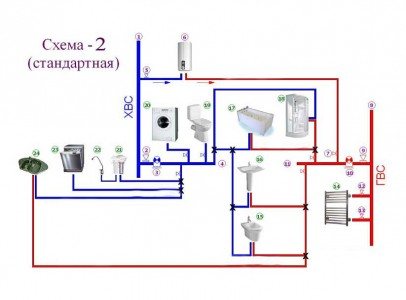
Standard layout of a home's hot and cold water supply system
All hot water supply systems can be divided according to several criteria:
- local hot water systems;
- centralized systems;
- open heating networks;
- closed heating networks.
According to the radius of action, hot water supply systems are divided into local and central.
Local hot water systems
Local hot water supply systems are installed for a group of small objects or one building. In this case, the water is heated directly by the consumer himself. Water is heated using gas or electric flow-type boilers.
Such systems require regular maintenance and are used only if it is not possible to use a centralized hot water supply.
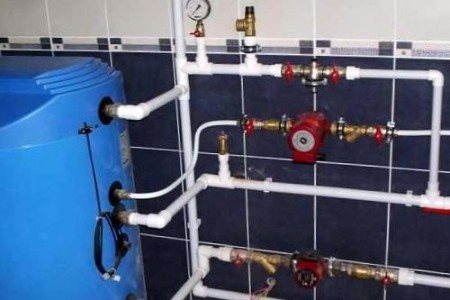
Local hot water system
Advantages of local hot water systems:
- autonomous work;
- ease of repair;
- small heat loss.
Central hot water systems
The emergence of central systems for supplying hot water to an apartment is due to the elimination of regional and local boiler houses, as well as heat supply systems. As for convenience, central hot water supply systems will be much more practical.
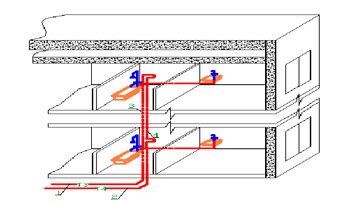
Scheme of centralized hot water supply for an apartment building
All this depends on the fact that there is no need to install appropriate equipment for heating cold water and additional wiring. Also, such a hot water supply system has its disadvantages. Pipes must be constantly maintained and repaired, but local utilities are rarely able to meet customer requests. There are also large differences in water pressure in the system and insufficient temperature, which cannot be said about local water supply systems.
To heat water and supply it to the consumer, centralized systems can use open or closed heating networks. Open heating networks involve mixing supply water with water already heated in special equipment. After this, the water is supplied to consumers. Closed heating networks provide for heating water through surfaces. The coolant (superheated water or steam) and the heated water do not come into contact in any way.
Open heating networks are considered more rational, but the quality of the supplied water may deteriorate significantly depending on the temperature regime. Such systems are very rarely found at the moment.
Closed circuit of heating and water supply of the house
Hot water supply in an apartment can be provided in several ways:
- Heating of water in the boiler room and subsequent supply to the consumer.
- Water is heated at special points located in neighborhoods or areas.
- Water is heated using special equipment that is installed in the basement of a multi-story building.
- Water is heated in the consumer’s apartment.
Hot water supply can be circulating. In this case, water constantly moves through the pipes and provides not only the supply of hot water, but also heating. The water is constantly heated. There is also a dead-end hot water supply. In this case, the water is not used immediately and may simply cool down over time. It is for this reason that special containers are installed in the apartment to heat and maintain water temperature.
As for savings, it would be rational to use individual systems for providing hot water to the apartment. For centralized hot water supply, the user must pay a monthly fee.
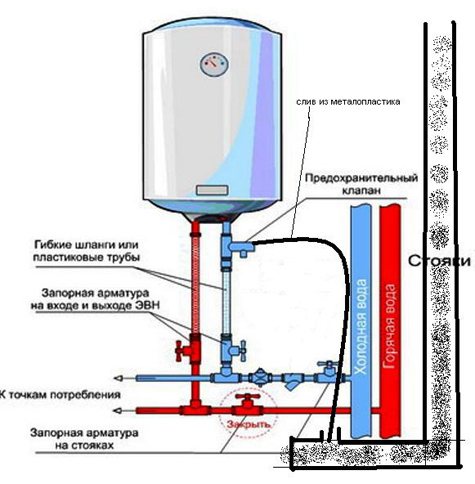
Diagram of a boiler for heating water
If it is possible to use a boiler to supply hot water to the apartment, then this will be the most economical option, since payment for water is made according to the cold water meter. The consumer provides hot water independently.
What to do if lukewarm water comes out of a hot tap?
Let's figure out how not to overpay for extra cubic meters.
– In our house there are often such cases that a little warm water runs out of the hot water tap. I measured: 30 - 40 degrees. And this happens 2-3 days every month. You have to skip it. Accordingly, we use much more hot water and overpay. I have a small child, and I fill a whole bath every day, so it costs a lot. Where can I go with this question?
The “Hygienic Requirements for Ensuring the Safety of Hot Water Supply Systems” (SanPiN 2.1.4.2496-09) sets clear requirements for the temperature of hot water: it must be no lower than 60 and no higher than 75 degrees Celsius. At the same time, another document - Decree of the Government of the Russian Federation dated May 6, 2011 No. 354 “On the provision of utility services to owners and users of premises in multi-apartment residential buildings and residential buildings” - establishes permissible deviations from these standards. So, at night - from 00:00 to 05:00 - the water temperature should not differ by more than 5 degrees, and in the daytime - from 05:00 to 00:00 - by no more than 3 degrees. It is noted that before determining the temperature, you need to run the water for some time, but no more than three minutes.
On this topic
Why do we pay for heat per square meter if the radiators do not work in all rooms?
4553
From these requirements, according to the same resolution, the terms of payment for the services provided also follow. So, if the water temperature is below the established 60 degrees, then the payment for hot water is reduced: for every 3 degrees of deviation from the permissible deviations, the payment for hot water in that month is reduced by 0.1% for each hour of violation. If the water temperature is completely below 40 degrees, then payment for the total hours of such a violation should be made at the rate for cold water supply.
Why is hot water lukewarm?
The reasons for insufficient water temperature can be very different.
Firstly, the problem may be in your own faucet: low-quality plumbing sometimes breaks off the partitions, and instead of hot water you get lukewarm water.
Secondly, your neighbors may be to blame. So, an incorrectly installed water heater or heated towel rail can affect the water temperature in your apartment.
Another reason may be improper regulation of the water supply. Simply put, your resource supply company does not sufficiently heat the water that goes to the apartments.
On this topic
The heat meter is broken, not installed, with a broken seal. What to do?
7713
Developers who incorrectly installed the pipes, or even the pipes themselves, or rather cracks on them, growths inside or depressurization, may also be to blame.
However, there may also be external reasons. For example, your home may be the last one on the hot water line. That is, first several high-rise buildings in front of you take hot water, and only after that the water supply goes to your house. If this line is not looped, then it turns out that in such a dead-end branch the hot water cools down, or even does not warm up to the required temperature at all.
What to do?
First of all, it is worth noting that there is no point in taking measurements of the water temperature in your apartment yourself - they will not be taken into account by specialists anyway. Therefore, Andrey Vorobyov, an expert at the Public Chamber of the Kirov Region, advises immediately contacting your management company:
– We must not forget about the right of every consumer to contact his own management company; no one will do this for you. After applying, you will have to measure the water temperature and draw up a corresponding report. If the temperature is lower than permissible, then by law you will be required to recalculate.
However, the following situation may arise: if your problem with cold “hot” water is not constant, but arises only from time to time, then by the time a specialist from the management company arrives, the temperature in the tap may well be close to the standards. Therefore, Andrey Vorobyov especially notes that in this case, only installing a meter with a temperature sensor can help: such a device considers it as cold when the water temperature is below 40 degrees. Accordingly, you will not be able to overpay for pseudo-hot water.
However, if you make such a decision, you may encounter some resistance from the management company. But the maximum that they can do is express their prohibition verbally, but it will not carry any legal force.
– In 2012, the Criminal Code of the Leninsky District decided to challenge in court the decision of the prosecutor’s office, which canceled the Criminal Code’s ban on installing meters with a temperature sensor. But the court did not take the management company’s side,” says Andrey Vorobyov. “Since then, I don’t know of a single case where a management company would refuse residents to install such devices.
On this topic
They don't pick up trash in the yard. Where to complain?
2231
If you decide to install a meter with a temperature sensor, you need to proceed as when installing a regular meter: write an application to the Criminal Code about your desire to install a new meter and indicate the desired installation date. If representatives of the management company come, they will have to put a seal and draw up a commissioning certificate. If no one shows up at the specified time, then you can install the meter yourself: the main thing is to do this in accordance with the meter’s passport, especially since in this regard it is no different from any other, so it is not so difficult to do. If no one from the management company came or contacted you about rescheduling within three days, then after 15 working days from the date of submitting the application to the Management Company, the meter is considered automatically put into operation - without certificates or sealing.
However, keep in mind that if interruptions in water temperature occur 2-3 times a month, then a meter with a temperature sensor will not help you - it simply will not pay for itself. Its installation makes sense if, due to insufficient hot water temperature, you lose at least 3 - 5 cubic meters per month.
And one more important point that also needs to be taken into account. Let's imagine a situation that all your neighbors, who are experiencing similar problems with hot water, decide to install such meters. In this case, less hot water will flow through individual hot water meters, but the indicators of the common house meter will not change. That is, all this “underheating” will go into the “heating” line and will be distributed as general house needs across all apartments. It turns out that residents will pay less for hot water and more for heating. And here the one who consumes the most hot water will save the most. And some may not save anything at all.
However, Andrey Vorobyov notes that if such a situation arises, it will be regulated at the legislative level. This was the case with general house needs for electricity, cold and hot water, when costs were transferred to the management company.
– For example, the current standard for common house needs for cold and hot water supply is 0.04 cubic meters per square meter of common property area. If you spend more, then the management company must pay the difference between the standard and actual consumption. The same scheme could be introduced for heating, says the expert.
Another solution to the problem of insufficient hot water can be a water heater. Modern equipment allows you to set and maintain the temperature you need. True, really high-quality equipment is quite expensive, and in this case it will no longer be possible to save the family budget. However, this is better than living without hot water at all. Therefore, in combination with a water meter with a temperature sensor, you can get, if not savings on the family budget, then at least the guaranteed availability of really hot water for the same money.
On this topic
Are building residents required to pay for an intercom?
39722
Andrey Vorobyov also talks about a third option for solving the problem with hot water supply: you can approach the issue globally and start reconstructing the water supply system. In this case, you will need to hold a general meeting of residents, make an appropriate decision at it with ⅔ votes and choose an option for financing this issue: either raise additional money for the reconstruction of networks, or include their renewal in a major overhaul.
In addition, we cannot exclude the possibility that problems with hot water arise due to the management company’s desire to save money. These are especially common in the summer, when people do not use hot water as actively. Everything happens roughly according to this scenario. Housing and communal services workers shut off the valve on the riser supplying hot water so that boiler houses do not operate at a loss. At this time, the hot water supply switches to a cold flow system, and cold water flows without circulation and constant heating.
As a result, when you call a measurer to draw up a report, hot water may suddenly appear, and after a while the situation may repeat itself. In this case, it will be very, very difficult to prove that you are right.
If you suspect your management company of dishonest performance of duties, then you have a direct path to the meeting of owners - to decide on the issue of changing the management company.
And now the most important thing - briefly:
- The standard temperature of hot water is 60 - 75 degrees.
- For every 3 degrees deviation from the permissible deviations, a recalculation is required for every hour; at a water temperature below 40 degrees, it is considered according to the cold water supply tariff.
- The cause of insufficient water temperature may be your own plumbing. If everything is fine with her, you need to contact the management company.
- If you lose at least 3 - 5 cubic meters of water per month, it makes sense to install a water meter with a temperature sensor, which automatically considers water below 40 degrees as cold.
- If the problem of hot water supply in your home has external causes that do not depend on the management company, a water heater may be the solution to the problem.
On this topic
8250
Where to work in Kirov to get paid well?
If you have questions that you cannot find answers to, ask us and we will definitely take them into development.
Heating in the apartment
Today there are a large number of water supply and home heating systems. All of them in some cases depend on each other. This applies to heating in an apartment building. If in a private house the heating system can be made in such a way that it does not depend on the water supply, then in an apartment everything is completely different. In the apartment, many engineering systems are closely interconnected
Heating in the apartment can be done with your own hands, only for this the entire work plan will need to be coordinated with utility services.
Very often there is a need to replace old heating pipes with new ones. Previously, cast iron was used for heating pipes. Metal tends to rust, and plaque constantly forms inside the pipe. This significantly reduces the permeability of pipes, which, accordingly, reduces the temperature in the apartment. You can carry out preventive maintenance every year and blow out such pipes. Or you can simply replace them with modern analogues.
To replace heating pipes, you need to carefully dismantle the old ones. This process must begin from the central riser. Such pipes were never hidden in the wall and even today you can see them in the corner of the room. At the moment, when replacing such pipes, it is possible to completely disguise them. You can hide the pipe in the wall, or you can use it to make some decorative elements.
Advice. Heating pipes should be replaced only after the end of the heating season, when there is no hot water in the system.

Modern water heating system for an apartment
The water supply system of an apartment building can be implemented in different ways. They all differ in the methods of collecting cold water, purifying it and supplying it to the end consumer. Due attention should be paid to the layout of pipes for water supply in the apartment. It is first necessary to estimate the amount of equipment that operates from the water supply.
Wiring in the apartment
There are two main schemes for distributing water supply in an apartment:
- tee (sequential),
- collector
Both schemes have their advantages and disadvantages. Sometimes it makes sense to use a combination of these schemes.
The sequential scheme is the traditional way of designing and installing water supply in an apartment. This circuit consists of one common pipe to which all devices are connected in series. Tees are used to connect plumbing fixtures, which is why this scheme is called a tee. The main pipe must be larger in diameter than the others, as it takes on the functions of a collector.
One of its significant advantages is the smaller number of pipes compared to the collector circuit. Therefore, the costs of its installation will be minimal.
The collector wiring diagram is the optimal choice for large apartments, as well as in places where the installation of a large number of plumbing fixtures is required. Water from the common riser enters the collector and is then sent to consumers, that is, to appliances.
Each consumer is connected separately. One of the main advantages of the collector circuit is the uniform distribution of water. This means that the number of connected devices and the length of water pipes do not reduce the pressure for any of the consumers.
The video demonstrates the cold and hot water input unit in an apartment in a multi-storey building.

